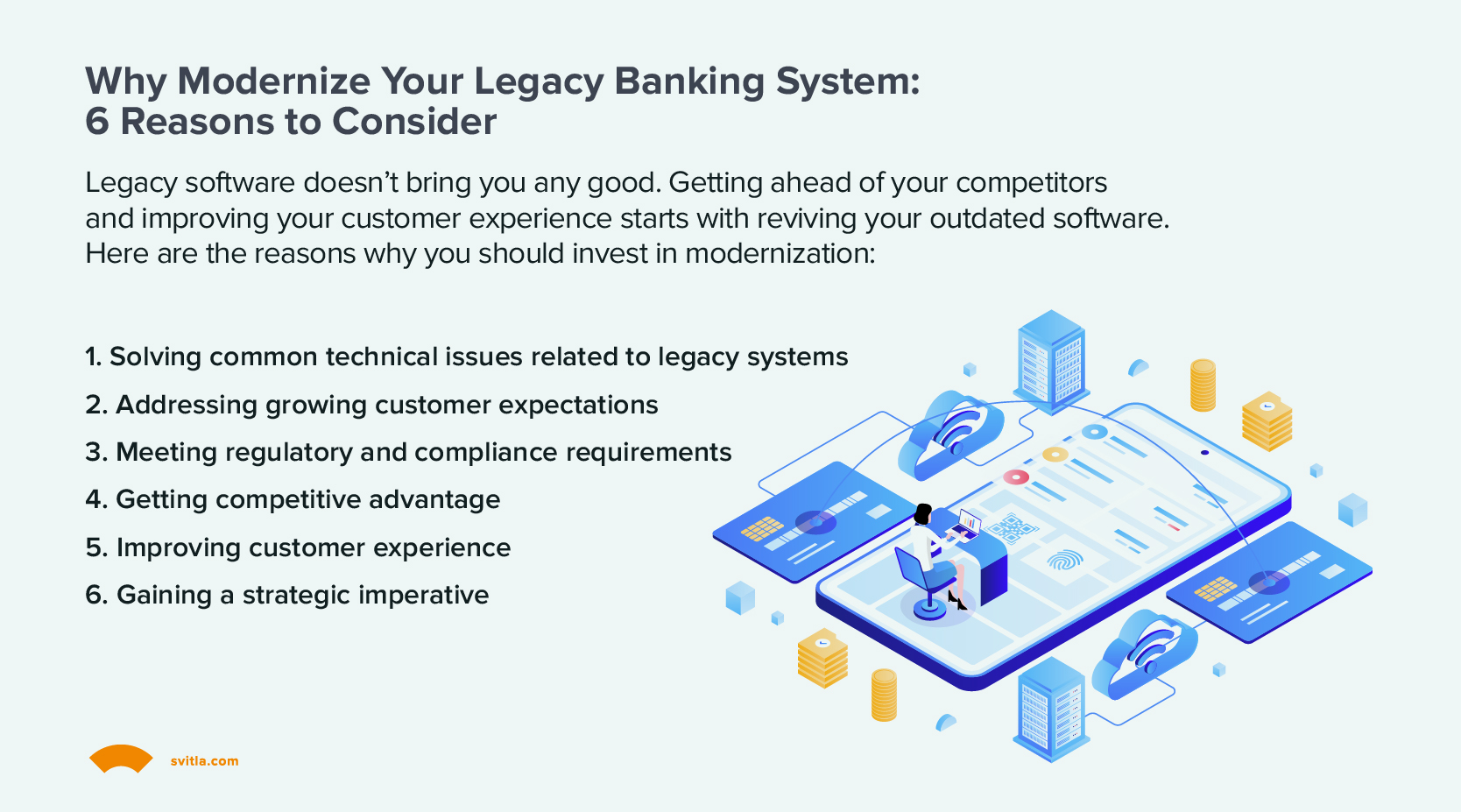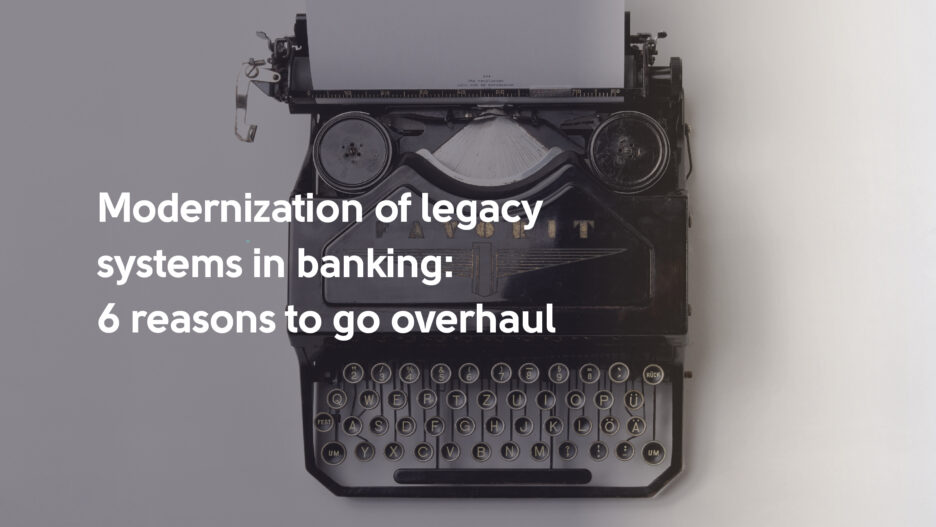In the dynamic financial sector, banks and financial institutions face evolving challenges on a regular basis. One of the most pressing issues is the continued dependence on legacy systems in banking, which are often ingrained within the operational structures of these entities.
Legacy systems in banking are followed by outdated technology and lack of adaptability to the rapidly changing digital environment, inhibiting operational efficiency, security, and innovation. In an era where customer expectations are escalating and the demand for real-time, seamless service is the norm, these outdated systems become more of a liability, undermining competitive advantage and agility.
Modernization of legacy systems in banking is a must that helps you enhance operational efficiency, reduce costs, and offer unprecedented value to customers. As banks take strides towards this transformation, integrating advanced technologies like artificial intelligence, machine learning, and blockchain, there emerges a renewed focus on agility, security, and customer-centricity. To forge a path that heralds a new era of banking excellence, we must balance the preservation of established processes with the integration of innovative solutions.
Why Modernizing Legacy Systems in Banking Matters
1. Common Issues Related to Legacy Systems
Legacy systems in banking are characterized by operational inefficiencies, rigid architectures, and a lack of adaptability, causing delays in transaction processing, limited functionality, and an inability to support the integration of modern technologies. The mounting maintenance costs and security vulnerabilities associated with these outdated systems further exacerbate the challenges faced by banks globally.
2. Evolving Customer Expectations
In the age of digital transformation, customer expectations are evolving at an unprecedented pace. Clients now demand instant, seamless, and tailored banking experiences, driven by the integration of technologies like artificial intelligence, machine learning, and blockchain. Legacy systems, with their inherent limitations, are ill-equipped to meet these demands, leading to reduced customer satisfaction and loyalty, and eventually, a loss of market share to more agile and technologically adept competitors.
3. Regulatory Changes and Compliance Requirements
The banking sector is also witnessing a surge in regulatory changes and compliance requirements, aimed at enhancing the security, transparency, and efficiency of financial transactions. Legacy systems, with outdated security protocols and limited data processing capabilities, struggle to comply with these evolving standards. This non-compliance not only attracts hefty penalties but also undermines the bank’s reputation, customer trust, and overall market standing.
4. Gaining Competitive Advantage
Modernizing legacy systems is pivotal for banks aiming to carve a niche and gain a competitive edge in today’s saturated market. The integration of contemporary technologies enhances operational efficiency, reduces costs, and facilitates the development of innovative, customer-centric solutions. Banks that embark on this journey of transformation are better positioned to adapt to market trends, customer expectations, and regulatory changes, driving sustainable growth and profitability.
5. Improving Customer Experience
At the heart of this modernization is the imperative to enhance customer experience. In a landscape where customer loyalty is intricately linked with personalized, efficient, and secure services, upgrading from legacy systems to modern, flexible, and robust technological platforms is non-negotiable. This transformation not only fosters innovation but also enhances the quality, speed, and reliability of banking services, culminating in elevated customer experiences and enhanced loyalty.
6. A Strategic Imperative
The strategic imperative for modernizing legacy systems transcends operational efficiency and customer experience. It’s a holistic overhaul that impacts every facet of the banking ecosystem, from internal operations and employee efficiency to external collaborations and partnerships. In an interconnected global economy, the agility, adaptability, and innovation fostered by modern systems enhance the bank’s competitiveness, resilience, and growth trajectory.
The path forward for banks is paved with opportunities and challenges. As financial institutions grapple with the decision to modernize their legacy systems, the focus should be on a strategic, phased, and holistic transformation. This not only mitigates the risks associated with transition but also ensures that the bank is poised to leverage the opportunities presented by digital transformation fully.

Benefits of Legacy System Modernization
Enhanced Operational Efficiency
Modernizing legacy systems translates into significant enhancements in operational efficiency for banks and financial institutions. The infusion of cutting-edge technologies facilitates seamless, real-time processing of transactions, a stark contrast to the sluggish, error-prone operations associated with outdated systems. Automated workflows, artificial intelligence, and machine learning algorithms reduce human errors and ensure that banks can deliver services that are not only swift but also customized to the unique needs of each client.
Improved Security and Data Protection
In a world where data breaches and cyber-attacks are rampant, the modernization of legacy systems is synonymous with bolstered security and data protection. Contemporary systems come equipped with advanced security protocols, utilizing technologies like encryption, biometrics, and blockchain to safeguard sensitive information. By transitioning away from legacy systems, banks enhance their resilience against cyber threats, ensuring that customer data is accorded the highest levels of security, and compliance with regulatory standards is effortlessly achieved.
Innovation and Customized Solutions
One of the most pronounced benefits of this modernization is the opportunity for innovation and custom solutions. Banks can develop innovative solutions without being constrained by rigid, outdated systems. With contemporary systems, banks can adapt to changing market trends and customer expectations rapidly and offer services aligned with the customer needs.
Cost Reduction
The shift from legacy systems also translates to a significant reduction in operational costs. The maintenance, repair, and updating of outdated systems drain financial resources, and the inefficiencies associated with these systems amplify operational costs. Modern systems, characterized by their efficiency, require less maintenance, are more energy-efficient, and are designed to integrate seamlessly with emerging technologies, ensuring that banks can optimize their operations without incurring exorbitant costs.
Customer Experience Enhancement
Providing exemplary customer experiences is the industry's core objective. Modern systems play a key role in accomplishing it. A bank that offers quick, secure, innovative, and cost-effective services is better positioned with enhanced operational efficiency, improved security, and cost reductions. The resultant effect is an enriched customer experience, characterized by personalized, efficient, and reliable services, which in turn fosters customer loyalty and positions the bank favorably in a competitive market.
How To Modernize Your Legacy System
Incremental Modernization vs. Full System Replacement
When considering the modernization of legacy systems in banking, two primary approaches emerge: incremental modernization and full system replacement. Incremental modernization involves updating and enhancing the existing system in phases, integrating modern technologies and features progressively. In contrast, full system replacement implies a complete overhaul, replacing the old system with a brand-new one. While each approach has its merits and demerits, a balanced examination reveals that incremental modernization often offers more flexibility and reduced risk.
The Pitfalls of Complete Redesign
A complete redesign, although seemingly appealing for its freshness and comprehensive update, is often riddled with challenges. It demands a significant investment of time, capital, and human resources. The transition can be abrupt, leading to potential operational disruptions, workforce adaptability issues, and customer service interruptions. Moreover, there’s the risk of data migration challenges and the potential loss of customized features that were ingrained in the old system, which can be detrimental to the bank’s operational efficiency.
The Merits of Incremental Modernization
Incremental modernization, on the other hand, offers a more controlled and manageable approach. By updating the legacy system in phases, banks can mitigate risks, minimize disruptions, and ensure that both employees and customers have adequate time to adapt to the changes. This approach allows for the preservation of essential customized features while integrating new, modern technologies progressively, ensuring that the bank continues to operate efficiently during the transition.
Cloud-Based Solutions
In the quest for modernization, cloud-based solutions have emerged as pivotal. Offering scalability, flexibility, and cost-effectiveness, these solutions are instrumental in enhancing operational efficiency and innovation. Banks can leverage the cloud to store, manage, and process data more efficiently, adapting to varying demands with agility.
Advantages and Potential Challenges of Cloud Computing
One of the merits of cloud-based is scalability, allowing banks to scale their operations up or down based on demand, ensuring optimal resource utilization. The flexibility inherent in cloud solutions enables banks to adapt to evolving technological trends swiftly. Cost-effectiveness is another significant advantage; with the cloud, banks can reduce operational and maintenance costs, paying for only the resources they use.
However, cloud-based solutions are not without their challenges. Security concerns, data privacy issues, and compliance requirements are pivotal considerations. Banks must ensure that the cloud service providers adhere to stringent security protocols, guaranteeing the safety and integrity of sensitive data. Moreover, navigating the complex landscape of regulatory and compliance requirements in the cloud environment demands meticulous planning and execution.
A Balanced Approach
A balanced approach to modernization involves blending the merits of incremental updates with the agility and efficiency of cloud-based solutions. By updating legacy systems in phases and leveraging the cloud’s scalability and flexibility, banks can achieve a modern, efficient, and responsive system without the risks and disruptions associated with a complete overhaul.
Investing in incremental modernization and integrating cloud-based solutions can help banks navigate the complex transition with fewer risks, enhanced efficiency, and optimal resource utilization. This approach ensures that the modernization not only addresses the limitations of legacy systems but also propels the bank into a future of innovation, agility, and competitive advantage in the digital age.
Challenges of Modernizing a Legacy System in Banking
Data Migration and Quality Issues
One of the paramount challenges of modernizing legacy systems in banking centers around data migration and data quality. The intricate process of transferring vast volumes of sensitive and complex data from old systems to new platforms can be fraught with complications. Ensuring data integrity, security, and quality throughout this process is vital. Banks often grapple with issues such as data loss, corruption, or inconsistencies, which can impact operational efficiency and customer trust.
Ensuring a Downtime-Free Transition
Ensuring a seamless, downtime-free transition during the modernization process is another significant hurdle. Legacy systems, having been operational for extended periods, are deeply entrenched in the banks’ daily operations. Transitioning to modern platforms must be executed with minimal disruption to services, requiring meticulous planning, testing, and execution. The objective is to mitigate service interruptions that can adversely affect customer experience and the institution’s reputation.
Technological and Operational Constraints
Moreover, technological and operational constraints often exacerbate the complexity of the transition. Legacy systems are characterized by outdated, rigid architectures that may not integrate seamlessly with modern, flexible platforms. The task of making these disparate systems communicate and function cohesively is intricate and demands specialized skills, innovative solutions, and considerable investment of time and resources.
Skill Gaps and Resource Allocation
Banks may also face skill gaps and resource allocation challenges. Modern systems require a different set of skills to manage, operate, and optimize. Building or acquiring this skill set, while simultaneously maintaining the legacy systems during the transition, can stretch the bank’s human and financial resources. Balancing the allocation of resources between maintaining operational efficiency and facilitating the modernization process is a delicate and often challenging endeavor.
Navigating Regulatory Compliance
Furthermore, in an industry that is heavily regulated, ensuring that the new systems adhere to regulatory compliance is crucial. Modernizing legacy systems isn’t just a technical upgrade but also involves aligning the new infrastructure with legal and regulatory standards. This alignment requires a comprehensive understanding of both the existing and emerging regulatory landscapes, adding another layer of complexity to the modernization process.
The ROI of Modernizing Your Legacy System
Calculating the ROI
Evaluating the Return on Investment (ROI) is a critical component in the journey of modernizing legacy systems within the banking sector. The calculation of ROI involves a comprehensive analysis of the costs associated with the modernization efforts compared to the anticipated financial gains and efficiencies. This is typically calculated by subtracting the cost of the investment from the total gain, divided by the cost of the investment, and is expressed as a percentage. In the context of legacy system modernization, costs can encompass expenditures on new technologies, training, data migration, and system integration, among others.
Short-Term Costs vs. Long-Term Benefits
Initially, financial institutions may experience significant upfront costs. These expenditures, while substantial, are investments into transforming operational efficiency, security, innovation capacity, and customer experience. The initial costs should be weighed against the myriad of long-term benefits, such as reduced operational costs, increased revenue from enhanced service offerings, improved customer retention due to enhanced service quality, and the opening of new revenue streams facilitated by innovative capabilities.
A Holistic View of ROI
When assessing the ROI, it’s imperative to adopt a holistic view, considering not just the tangible financial gains but also the intangible benefits such as enhanced brand reputation, increased customer loyalty, and improved agility to adapt to market trends. In the long term, the modernization of legacy systems catalyzes a transformation that extends beyond monetary returns. It fosters an environment of innovation, efficiency, and adaptability, positioning the bank to navigate the future landscape of the financial sector with enhanced capability and competitiveness.
Wrapping Up
The imperatives for modernizing legacy systems in banking are compelling and multifaceted. As banks navigate this complex landscape, the focus should be on aligning the transformation with organizational goals, market trends, and customer expectations. It’s not just about technology but a strategic repositioning that enhances the bank’s value proposition, customer experience, and market standing in a digital, interconnected global economy.
As we delve into the journey of modernizing legacy systems in banking, the expertise and proven track record of Svitla Systems stand as a beacon of innovation and efficiency. We pride ourselves on our in-depth knowledge, technical prowess, and customized solutions tailored to address the unique challenges and opportunities present in the banking sector. Our team has demonstrated excellence in transforming legacy systems into modern, agile, and efficient digital platforms, as evidenced by our successful cases and enduring partnerships with leading financial institutions.
We are dedicated to crafting bespoke strategies that align with your specific operational, technological, and financial landscapes. We harness the most viable, innovative technologies to ensure your banking system is not only modern but also responsive, secure, and aligned with emerging trends and customer expectations.
With Svitla Systems as your partner, the digital transformation journey of your legacy systems is navigated with precision, innovation, and a relentless focus on delivering value, ensuring that your bank is positioned to thrive in the digital age.





![[Blog cover] SEO optimization best practices](https://svitla.com/wp-content/uploads/2025/05/Blog-cover-SEO-optimization-best-practices-560x310.jpg)